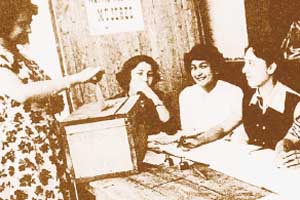The radical party had emerged almost a century ago, in the middle of the debate that generated the enactment of the Constitution of 1833. With the arrival of the XX century, it transformed in the most representative political force of the middle class, achieving a great quantity of supporters and even obtained great support from the socialists and communists. With them, in 1937, the Popular Front was formed, which was the political movement that fought the arrival of the opposition to the power, obtaining it in three opportunities, with the triumphs of Pedro Aguirre Cerda, Gabriel González Videla and Juan Antonio Ríos.
To govern is to educate
In the presidential elections of 1938, Pedro Aguirre Cerda, who was the representative of the Popular Front, and Gustavo Ross, who was supported by conservatives and liberals faced each other. After a close election, which was defined by only one point of difference, the first resulted as the winner, with 50.2% of the votes. In this way the first radical government was beginning, characterized by the strong impulse that was given to the industry and education as the engines for the growth of the country.
According to the words of Aguirre Cerda, «the education is the first duty and the highest right of the State; accordingly, socially and juridically considerate, the tasks of educating and teaching are a function of the State”. His strong conviction then resulted in an ambitious plan of education, which included the construction of numerous educational facilities (more than 1.000 primary schools), the opening of new work squares for teachers, the foundation of experimental high schools and the strong impulse given to the professional-technical education.
While inside his plan was the encouragement (promote) of the national industry, there was a determining fact that directed the plans of government. On January 24th of 1939 a strong earthquake shook the country between the regions of Maule and BioBio, Chillan being the most affected city.
It was then necessary an urgent reconstruction plan of the devastated zones, which allowed the enactment of the law 6.334, which was created by the Coporacion de Reconstruccion y Auxilio (Reconstruction and Help Corporation) and the Corfo.
During this government, the supreme decree that set the limits of the Antarctic Chilean Territory was additionally dictated in 1840, between the meridians 53° and 90° of west longitude and the South Pole. Thus, our country reached a surface of 1.250.000 km2 in the white continent, where important scientific bases were installed later on.
Pedro Aguirre Cerda could not finish his ruling, because he died on november 25th of 1941, being a fulminating victim of tuberculosis. A strong fight for the power started after his death. On February 1st of 1942, with the 55.93% of the votes, Juan Antonio Rios resulted as the winner, a candidate of the left party who was initiating a new government from the radical lines.
To govern is to produce
Juan Antonio Ríos assumed the presidency of the country on April 2nd of 1942. During the years that his ruling lasted, until 1946, he continued the implementation of strong industrialization politics. Anew with the Corfo as the central protagonist of the advancements, important organisms were created, such as Endesa, in 1944; the Empresa Nacional del Petrelo (Enap) (The National Company of Petroleum) in 1945, and the Compañia de Acero del Pacifico (CAP) (The Steel Company of the Pacific), in 1946. In this way, the theme of his campaign «To govern is to produce» was shaped in concrete facts.
Also the government developed an important agriculture boosting plan, with the introduction of new technologies and work methods. In this way it was intended to reach high levels of production that allowed the exporting of an important part of the resources coming from agriculture, opening new markets for the country.
In the international ambit, Chile left behind the neutrality adopted before the Second World War. Although, the conflict had exploded in 1939, just under the ruling of Juan Antonio Rios, and after the economical and political pressures exercised by the Unites States, our country broke its diplomatic relationships with the Axis countries (Germany, Italy, Japan), on January 20th of 1943.
Just like his predecessor and after a strong health deteriorating, Juan Antonio Ríos died before finishing his ruling, on June 27 of 1946.
Brake in the governing coalition
After the death of Juan Antonio Ríos, four candidates disputed the presidency of the country. In a close voting, González Videla reached the majority, with a 40.1% of the votes. However, it was the responsibility of the Parliament to decide between the two candidates with the highest voting (the second candidate was Eduardo Cruz Coke).
After numerous negotiations, on November 24th of 1946 the plain Congress proclaimed Gabriel González Videla as the president of the Republic.
His mandate was marked by the political differences that emerged among the parties that were supporting him. The disagreements reached to the point that one of the main pillars of his candidature, the Communist party, was isolated from the government, provoking the division of the Popular Front. Regarding the fundamental objectives that González Videla was proposing for his government were the following: the growth and technology of the country. In this way, the construction of the iron and steel plant of Huachipato continued and he initiated the works in the refinery and pipeline of Concon and the refinery of Paipote. Also, on January 30th, 1952, the Industria Azucarera Nacional S.A. (National Sugar Industry) (Iansa) was born, which had intentions of developing the southern zone of the country.
There was also progress in the social arena, like the advances achieved with the approval of laws related to paying weekly salaries, capping the amounts paid for renting rooms and the law regarding the irremovability of private employees. But without a doubt one of the most important milestones for the evolution of culture and politics in the country took place on January 8th, 1949, date on which Law Nº 9.292 was promulgated, which granted women the right to vote in the presidential elections.








 Muere Evita
Muere Evita